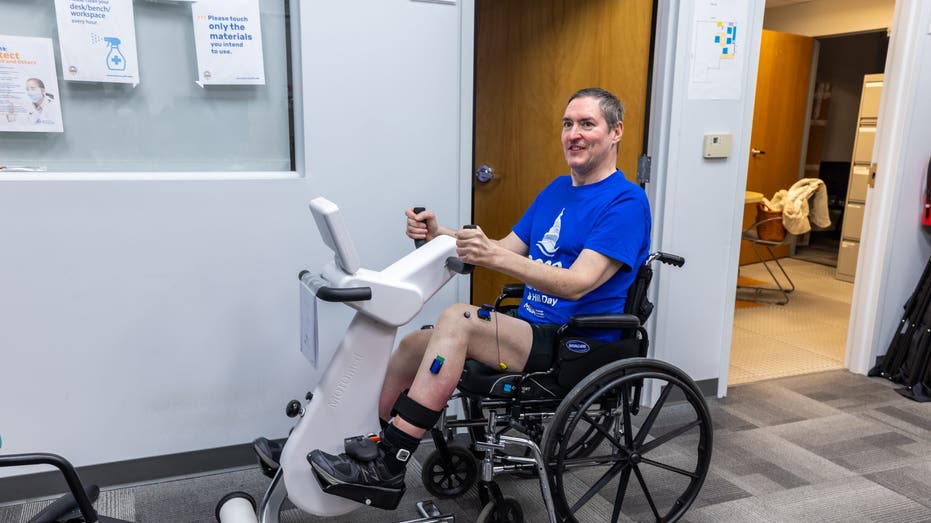
New research suggests that electrical spinal cord stimulation could improve muscle function for patients who have spinal muscle atrophy, even restoring the capability to walk.
People with spinal muscle atrophy (SMA), an inherited neuromuscular disease, usually experience muscle weakness that impacts movement.
New research suggests that electrical spinal cord stimulation could improve muscle function for these patients, even restoring the capability to walk.
In studies at the University of Pittsburgh School of Medicine, sessions of spinal cord stimulation were shown to restore motor neuron activity and improve muscle strength in the legs for patients with SMA.
The findings were published in Nature Medicine on Feb. 5.
SPINAL CORD TREATMENT RESTORES FUNCTION FOR PARALYZED PATIENTS IN STUDY: ‘NEW HOPE’
“The patients all had a rare disease that destroys neurons in the spinal cord (much like polio) due to a genetic disorder from birth,” Dr. Peter Konrad, chairman of the Department of Neurosurgery at WVU Rockefeller Neuroscience Institute in West Virginia, told Fox News Digital. (Konrad was not involved in the study.)
“The disease weakens the legs and ability to walk … causing a form of slow paralysis. Stimulation of the input to the remaining neurons was thought to improve strength and stamina in patients treated this way.”
Study co-author Marco Capogrosso, assistant professor of neurological surgery at Pitt School of Medicine, said that two things need to happen to counteract neurodegeneration: neuron death must be stopped and the function of surviving neurons must be restored.
“In this study, we proposed an approach to treat the root cause of neural dysfunction, complementing existing neuroprotective treatments with a new approach that reverses nerve cell dysfunction,” Capogrosso said in a press release.
Three people with SMA participated in the study. For one month, they received spinal cord stimulation five times a week for four hours each. At the end of the trial period, they all experienced “improved motoneuron function, reduced fatigue and improved strength and walking in all participants,” the release stated.
“The three patients saw an average of 40% improvement in step length, up to 180% improvement in strength, and 26-minute improvement in walking time,” said Konrad, based on his review of the study.
For more Health articles, visit www.foxnews.com/health
“That’s a big deal for patients with this condition, who depend on assistive devices to move about with little stamina.”
One of the participants, Doug McCullough, was experiencing advanced symptoms and had difficulty walking.
NEW BRAIN THERAPY ALLOWS PARALYZED PATIENTS TO WALK AGAIN: ‘I FEEL MY LEGS’
“Because my hip flexors are so weak, I basically have this waddling gait where my hips sway back and forth and I swing my legs out to the side because I can’t pick them straight up,” he said in the release. “You could clearly see from the video that my walk was improved and that I was walking faster. I had a little more natural gait. It still wasn’t completely normal, but it was better than what it was before the study.”
Although SMA is a progressive disease that worsens over time, the patients in the study had noticeable improvements, according to study co-author Elvira Pirondini, assistant professor of physical medicine and rehabilitation at Pitt School of Medicine.
“Over the four weeks of treatment, our study participants improved in several clinical outcomes, with improvements in activities of daily living,” she said in the release.
CLICK HERE TO SIGN UP FOR OUR HEALTH NEWSLETTER
“For instance, toward the end of the study, one patient reported being able to walk from their home to the lab without becoming tired.”
The study is a “proof of concept” that gives hope to people with this type of genetic disability, according to Konrad.
“There has been no major breakthrough in curing this disease, and so treatment is still focused on helping improve their quality of life,” he told Fox News Digital.
“It also shows that devices such as spinal cord stimulation and other types of neuromodulation are a safe and effective method to treat paralysis when there is little to offer in the form of medications or gene therapy.”
Looking ahead, the team plans to continue research with other SMA patients in a new clinical trial to test the treatment’s safety and efficacy.
In the future, they hope to apply this therapy to other neurodegenerative diseases, such as ALS or Huntington’s disease.






